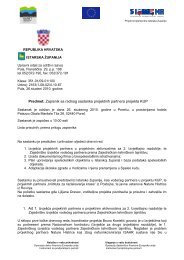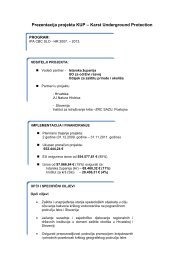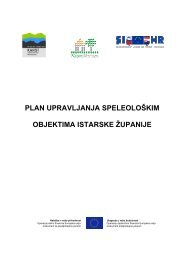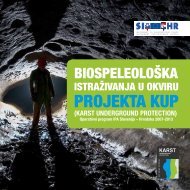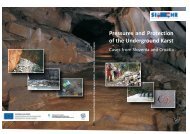Case Studies from the Dinaric Karst of Slovenia
Case Studies from the Dinaric Karst of Slovenia
Case Studies from the Dinaric Karst of Slovenia
Create successful ePaper yourself
Turn your PDF publications into a flip-book with our unique Google optimized e-Paper software.
Structural poljes are dominated by bedrockgeological controls. This type <strong>of</strong> poljes prevailson <strong>the</strong> <strong>Dinaric</strong> karst. They are connected withgraben or overthrust structures, or as inliers <strong>of</strong>less karstified rocks like dolomite, marl or evenflysch.Baselevel poljes occur where dissolutionhas lowered <strong>the</strong> karst surface to <strong>the</strong> regionalepiphreatic zone. Typically <strong>the</strong>se poljes developin lower parts <strong>of</strong> <strong>the</strong> karst, but <strong>the</strong>y alsooccur in higher parts <strong>of</strong> <strong>the</strong> <strong>Dinaric</strong> mountainswhere impermeable formations may act as hydrologicalbarriers.<strong>Dinaric</strong> poljes are polygenetic features.They are generally elongated along <strong>the</strong> strike<strong>of</strong> <strong>the</strong> Dinarsko gorovje (i.e. in a northwest—sou<strong>the</strong>ast direction). Poljes are developed atall elevations, between 1,200 and 20 m abovesea level. A complex suite <strong>of</strong> processes governs<strong>the</strong>ir genesis. They develop along regionalfaults, graben structures and overthrust. Thehighest is Trebistovo polje, (1,278 m a.s.l.) and<strong>the</strong> lowest are Bokanjačko polje and Vrgoračkojezero (Vrgorac lake; only 20–25 m a.s.l.).The largest poljes are Liško polje (460 km 2 )and Livanjsko Polje (65 km long and 6 km,402 km 2 ), but <strong>the</strong> majority <strong>of</strong> poljes are smaller,covering only few 10 km 2 .In natural conditions floods are normalphenomena for many poljes. In some poljeslike Cerkniško polje and Buško blato <strong>the</strong>y lastedabout half a year. The flooding <strong>of</strong> 60 kmlong Popovo polje under natural conditionsreached a height <strong>of</strong> 40 m in <strong>the</strong> lowest section<strong>of</strong> <strong>the</strong> polje, and <strong>the</strong> average yearly flood durationwas 253 days.Poljes are very important for human settlement.In <strong>the</strong>m <strong>the</strong> best, and <strong>of</strong>ten only, arableland in <strong>the</strong> <strong>Dinaric</strong> karst is available. There isalways some water available and floods areregular and limited to lower parts <strong>of</strong> poljes, soall <strong>of</strong> <strong>the</strong> largest settlements are located <strong>the</strong>re.Fig. 27: Klekovača and Materniča uvala are two large closed depressions nor<strong>the</strong>rn <strong>of</strong> Livanjsko polje in Bosnia. Note that <strong>the</strong>bottom <strong>of</strong> large uvala is dotted with dolines (DEM source: ASTER GDEM 1”, figure made by: A. Mihevc).36



